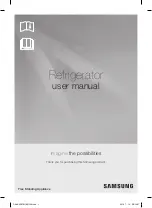
13
7. Replace the door in its new position. Ensure that the
hinge pin is inserted into the guide bushing (hole) on
the lower part of the door frame.
8. Attach the upper hinge plate (removed earlier in step
2) on the left-hand side with 2 screws. Ensure that the
hinge pin is inserted into the guide bushing (hole) on
the upper part of the door frame. Insert and tighten the
other 2 screws on the other side
9. Adjust the closed door to its proper position and tighten
the screws of the upper and lower hinge plates.
10. Replace the top panel and tighten the screws at the
back
11. Put the unit back in its intended position and wait for
about four hours before connecting it to the mains.
Temperature control
∙
The unit is
re-activated by
connecting it to
the mains. It is
only switched
off completely when the plug is removed from the wall
socket.
∙
The temperature in the refrigerator cabinet can be
adjusted by setting the temperature control. Turning the
control clockwise will decrease the temperature, while
turning it anti-clockwise will increase it.
∙
Initially, the temperature control should be set to
6
or
7
(
rapid cooling
), but after 30 minutes it should be brought
back to a medium setting which is adequate for normal
home use.
∙
Caution:
The control must not remain set at
6
or
7
for
more than three hours before being reduced to a medium
level – depending on the ambient temperature, the
interior temperature may otherwise drop too low.
∙
Following a power interruption, or if the unit has been
switched off on purpose, it may take 3 to 5 minutes
before it switches on again.
In position ‘0’, the cooling function is switched off,
though the appliance is still connected to the mains.
Storing food
∙
The temperature inside the refrigerator depends mainly
on the ambient temperature, the temperature control
setting and the amount of food stored.
∙
Different areas of the refrigerator cabinet are affected
differently by the cooling effect. The warmest area is
around the door in the higher part of the cabinet, the
coldest around the rear wall and in the lower part of the
cabinet.
∙
The food should therefore be stored as follows:
∙
On main cabinet shelves
(from top to bottom): bakery
items, ready meals, dairy products, meat,
fi
sh and cold
meats/sausages.
∙
In the vegetable compartment:
vegetables, salad and
fruit.
∙
In the door
(from top to bottom): butter, cheese, eggs,
tubes (eg mustard), small bottles, large bottles, milk and
fruit-juice tetra-packs.
∙
Initially, the temperature control should be set to position
4
. If the cooling effect is too strong, lower it to position
1-3
; if it is insuf
fi
cient, raise it to
5-7
.
∙
If you notice frost on the rear wall, the most likely
cause is that the door has been left open for too
long, or that warm food has been placed inside the
refrigerator or that the temperature control has been
set too high.
∙
Liquid or strong-smelling food, or food which is likely to
absorb strong odours (e.g. cheese,
fi
sh, butter), should
be stored separately or in hermetically sealed containers.
Содержание KS 9818
Страница 73: ...73 R600a GR...
Страница 74: ...74 R600a 8 2...
Страница 75: ...75 1 2 3 LED 4 5 6 7 8 9 10 11 30 30 4 70 160 7 5 cm 10 cm...
Страница 76: ...76 1 2 3 4 5 1 2 6 7 8 5 2 2 2 9 10 11 4...
Страница 77: ...77 6 7 30 6 7 3 5 0 4 1 3 5 7...
Страница 78: ...78 0 30 30 30 4...
Страница 79: ...79 KS KS 9818 7 A kWh 93 137 24 N ST T C 16 43 dB a 40 x x mm 845 x 560 x 575 28 1060 2010 III 22 12 2016...
Страница 80: ...80 R600a RU...
Страница 81: ...81 R600a 8...
Страница 82: ...82 2 1 2 3 4 5 6 7 8 9 10 11 30 30 4 70...
Страница 83: ...83 160 7 5 10 1 2 3 4 5 1 2 6 7 8 2 2 2 9...
Страница 84: ...84 10 11 4 6 7 30 6 7 3 5 0 4 1 3 5 7...
Страница 85: ...85 0...
Страница 86: ...86 30 30 30 4 Severin 2 a x KS...
Страница 87: ...87 KS 9818 7 A 93 137 frost free frost free N ST T C 16 43 40 x x 845 x 560 x 575 28 1060 2010 III 22 12 2016...
Страница 88: ...88...
Страница 89: ...89...














































